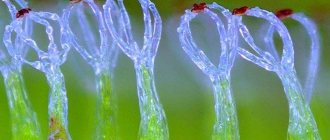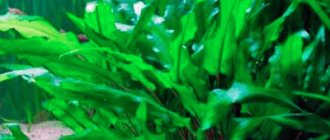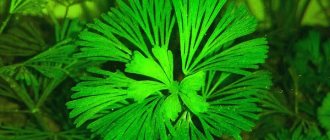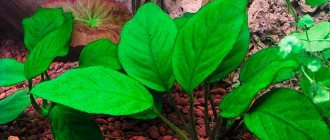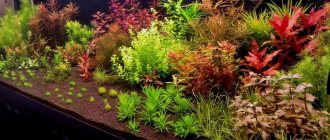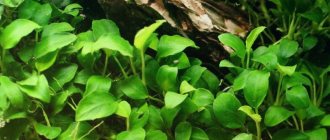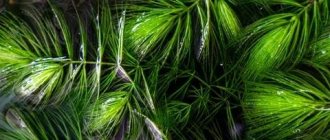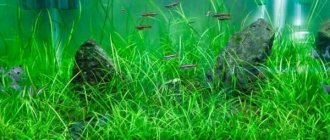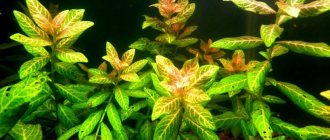Thai fern is a very popular aquarium culture. Its wide distribution is largely due to its unpretentiousness and excellent adaptability. The plant grows well, does not need fertilizer, does not need additional lighting, and is a great companion to various aquarium inhabitants. The Thai fern looks very nice. Its size, shape and color of leaf blades may vary depending on the variety of the plant itself.
Habitat and appearance characteristics
The Thai fern is native to Asia. Belongs to the centipede family. Can grow both on land and in water. An attractive aquarium culture that forms dense thickets. No special requirements for soil, lighting, free space.
The foliage of the Thai fern has a bright green color, growing quickly to form a beautiful, dense shrub. The average height is about 20-25 cm.
Develops evenly throughout the year. Perfectly suitable for decorating and decorating any artificial pond plan. The crop propagates vegetatively.
Thai fern
Thai fern photo
Range – tropics of Southeast Asia.
The Thai wing fern (Microsorum pteropus) is popular among aquarists. The long rhizome of the fern has lanceolate bright green leaves that reach a height of 30 cm and form dense thickets. This fern can be grown in any size aquarium.
Comfortable water parameters for Thai fern: temperature not lower than 24 °C (as the temperature drops, its growth stops). Hardness no more than 6°, pH 5.5-7. Such conditions are usually created in old water. Therefore, frequent replacement of fresh water is not necessary. Lighting is moderate. The fern can withstand prolonged shading. Daylight hours should be approximately 8-12 hours.
Thai fern photo
Soil parameters do not matter. The rhizome of the fern is always located on top of the soil; the silt accumulated at the bottom is quite enough for the plant. Therefore, in an aquarium with soil, the nature of the substrate particles does not matter.
In an aquarium, ferns reproduce only vegetatively. The rhizome of the plant is divided into parts with 2-3 leaves. From each part a new plant is formed.
Thai vindelova fern photo
Thai vindelova fern photo
The Thai fern has several varieties: red (Microsorum pteropus “Red”), Small leaf (Microsorum pteropus “Small leaf”), True narrow-leaved (Microsorum pteropus “Real Narrow”), Fork-leaved (Microsorum pteropus “Fork Leaf”), Thailand “Tropical” "(Microsorum pteropus "Tropica"), Windelov (Microsorum pteropus "Windelov"), Philippine winged (Microsorum pteropus "Philippine"), Microsorum pteropus "Undulata", Thai narrow-leaved (Microsorum pteropus "Narrow"), Thai narrow-leaved (Microsorum pteropus " Narrow K").
All of the above is just the fruit of observing this type of aquarium plant and collecting various information from owners and breeders. We would like to share with visitors not only information, but also live emotions that allow us to understand the world of aquariums more fully and subtly. Register at https://fanfishka.ru/forum/ , participate in discussions on the forum, create profile topics where you will talk about your aquatic organisms in the first person and first-hand, describe their content features, and share with us your successes and joys , share experiences and learn from the experiences of others. We are interested in every bit of your experience, every second of your joy, every awareness of a mistake, which makes it possible for your comrades to avoid the same mistake. The more of us there are, the more pure and transparent drops of goodness there are in the life and everyday life of our seven billion society.
Thai fern video review
Conditions of detention
The Thai fern can easily be classified as the most unpretentious, unpretentious aquarium crop. This plant does not need soil.
It is strictly forbidden to bury seedlings in the ground, but they will feel great tied to snags and underwater pebbles. Thick threads and fishing lines are perfect for these purposes, which aquarists prefer to use due to their inconspicuousness in the water.
The slow growth rate makes the fern a suitable decoration for even small aquariums. In addition, this feature eliminates the need for aquarium owners to regularly thin out and trim the tops of the plant.
The Thai fern does not need too much light and tolerates shade well. But excessively intense illumination, on the contrary, can harm it, causing damage, thinning and darkening of leaf blades.
It is recommended to use weak fluorescent lamps for additional lighting.
Daylight hours should last at least 12 hours; only in this case can you count on the formation of a beautiful, healthy shrub with bright, eye-catching foliage.
Since the plant receives most of its microelements and nutrients from water, it will respond well to additional liquid fertilizers. It is recommended to fertilize regularly after cleaning the pond and changing the water. It is important to use the liquid form of fertilizer; tablet preparations for Thai fern will be useless due to the lack of rhizomes.
The best habitat for an aquatic plant will be soft, moderately acidified water. However, the plant is quite resistant to changes in these indicators. The same applies to temperature conditions.
However, it should be remembered that when the water cools to +18°C and below, the growth processes of the Thai fern slow down and then stop altogether.
Thai angustifolia fern
Thai angustifolia fern
Habitat in nature
Homeland - the tropics of Southeast Asia.
Description and types
Of the group of underwater ferns, it is the most unpretentious and shade-tolerant. The height does not exceed 25-30 cm. The width of the bush is 12-20 cm. On a long creeping rhizome-rhizome, lanceolate leaves from bright green to dark green are alternately located. The leaves reach a height of 25-30 cm and form dense thickets. The leaves are hard, simple, lanceolate, bright green, on short petioles. It has an uneven, as if crumpled, surface, which gives the microzorum thickets a special originality. It grows throughout the year, but very slowly even under the most favorable conditions.
— Microsorium pteropus “Filipine” — The leaves are thinner, variable in length from 20 to 30 cm, and very narrow, from 1 to 2 cm. This variety can tolerate the presence of salt, especially suitable for use in brackish aquariums. It can also be planted not too deep into the ground; — Microsorium pteropus “Narrow Leaf Nana” — Narrow-leaved dwarf; — Microsorium pteropus “Narrow Leaf” — The Thai narrow-leaved fern has narrower leaves that grow at a less acute angle from the stem, up to 15-20 cm long. It takes root much easier in any environment; — Microsorium pteropus “Needle Leaf” — Leaves are narrow with more horizontal growth. Also, the rhizomes are thinner compared to the norm; — Microsorium pteropus “Red” — They have a leaf wider than the original appearance, but its main feature is the reddish-brownish new leaves, but with age this color turns into the classic green color;
— Microsorium pteropus “Trident” — Leaves are slightly darker, very thin (even less than 1 cm), but with extensions of several centimeters, creating a continuous row of long tridents; — Microsorium pteropus “Tropica” — Has faster growth and looks more voluminous, leaves up to 45 cm, however, the main differences are in the morphology of the leaves: in the juvenile form they are serrated, with age the teeth gradually lengthen to variable length and width; — Microsorium pteropus “Undulata” — Slightly larger than the original form with wide leaves up to 4 cm wide; — Microsorium pteropus “Windeløv” — This variety is smaller, leaves up to 20 cm long, denser and denser bush. Characterized by branching branches at the ends of small leaves;
Content
Grows satisfactorily in water at temperatures above 24°C. As the temperature decreases, growth slows down. Water characteristics and especially hardness are very important for the successful cultivation of this plant. The total hardness should not exceed 6°dH, and the active reaction of the water should be from slightly acidic to neutral (pH 5.5-7.0). Such conditions are usually created in old water. In this regard, frequent water changes are not required for the winged fern; it can even somewhat slow down its growth. In hard water, black spots appear on the leaves or the edges turn black. In addition, microsorium does not tolerate high concentrations (1.5 g per liter) of salts in water. Therefore, you should not add salt to the water. In most areas of our country, natural water is unsuitable for growing winged ferns due to its relatively high hardness. Intense air blowing and strong water flow impair plant growth.
The lighting is moderate (0.4 W/l), it can withstand prolonged shading, but its growth practically stops. However, bright light is required to produce large, beautiful bushes with ruffled leaves. Daylight hours are 12 hours. In good conditions, fern leaves remain pure green for years, but in poor conditions they become covered with black spots of dead tissue. The leaf blade is so dense that, even when completely blackened, it remains in its original place for a long time.
Forms a highly branched creeping, hard, dark green rhizome. Single alternate leaves extend vertically upward from it; the adventitious roots are dark brown, covered with small fibers. The root system of this fern tends to attach to individual pebbles that make up the soil of the aquarium. To improve fern growth rates, it is recommended to periodically, approximately 1-2 times a month, apply mineral fertilizer. It is recommended to place a piece of boiled sour peat under the roots. Mineral fertilizers added to the water have a positive effect on growth. The nature of the substrate does not matter, since the rhizome spreads over the surface of the solid base of the soil without penetrating deeper. The fern takes root equally well both on coarse soil and on stones. This is exactly how the plant should be planted: without burying the rhizome into the ground.
This fern can be grown in an aquarium of any size, placing it near the side walls and in the middle ground. In a small pond, the bush will play the role of a large single plant; in a spacious one, it can be used for group planting. It can form the basis of very beautiful compositions. Microzorum is also used as a spawning substrate for many spawning fish. The plant grows well on wood, stone and in a floating state, which does not last long, since under its weight it sinks to the bottom. It has no roots and does not need to be planted in the ground, but with the help of root-like formations - rhizoids, it easily attaches to stones, snags, etc. therefore, first it must be pressed with a stone. If the plant is planted in the ground, then you should not bury the rhizoids, otherwise they will rot.
When growing a microzorium, it is necessary to take into account that it does not tolerate disturbance at all and the presence of suspended organic particles in the water. In the aquarium where it grows, it is necessary to replant plants and catch fish as rarely as possible. Intensive purging of the aquarium, strong water flow and the presence of fish in the aquarium that dig the soil significantly impair the growth of this fern. Gives 1 sheet per month. As a rule, it is not eaten by herbivorous fish. Even under optimal conditions it grows slowly. If the plant is not disturbed, it grows to enormous sizes. Old bushes in an aquarium can form dense thickets. The plant is undemanding, so it is suitable for growing by beginning aquarists.
Reproduction
The fern is easily propagated by cuttings, pups that develop on the top of old leaves, as well as by spores that form on the underside or along the edge of the leaf, sometimes on adventitious roots. Black spots on the undersides of leaves are spores and not signs of disease, as many people mistakenly believe. Buds form on old, decaying leaves, from which small ferns develop. After the death of the old leaf, the daughter plants break off and float to the surface. A floating young plant gradually develops a rhizome, under the weight of which it sinks to the ground. The large rhizome of the plant is divided into parts with 3-4 leaves. From each such part, a young plant is then formed.
What problems may arise
Thai fern is hardy and stress-resistant. The main problem that aquarists face when growing plants is a slowdown in growth caused by a deficiency of nutrients and valuable microelements. This can be avoided by applying liquid fertilizers in a timely manner.
In addition, it is necessary to monitor the acidity of the aquatic environment, since when it increases strongly, the fern leaves begin to turn black and deteriorate. When digging up the ground, bottom-dwelling fish can damage and injure the weak roots of an aquatic plant, preventing its growth and reproduction, so it would be better to avoid such a neighborhood.
Thai fern (Microsorum pteropus)
Centipede family – Polypodiaceae. Homeland - the tropics of Southeast Asia.
A very widespread aquatic plant among aquarists. Lanceolate bright green leaves alternately located on a long rhizome reach a height of 25–30 cm and form dense thickets. This fern can be grown in an aquarium of any size, placing it near the side walls and in the middle ground. This plant is not very demanding, but the conditions for its maintenance have some peculiarities. In the aquarium it grows evenly throughout the year.
Microsorium develops satisfactorily in a tropical aquarium at a temperature not lower than 24 °C. Even under optimal conditions it grows slowly. As the temperature drops, its growth slows down further. Indicators of water hardness and active reaction are very important for microzoria. Soft water with a hardness of no more than 6° is most suitable for it. The active reaction must be neutral or slightly acidic (pH 5.5 - 7). Such conditions are usually created in old water. In this regard, frequent water changes are not required for the winged fern; it can even somewhat slow down its growth. In a general aquarium, the microsorium best tolerates changing 1/6-1/5 of the water volume about 2 times a month.
Lighting can be strong or moderate. The fern can withstand prolonged shading, but grows well only with sufficient light. Natural diffused light has a positive effect on the development of the microsorium. Incandescent and fluorescent lamps can be used as sources of artificial light. The power of the illuminator is selected individually depending on the needs of neighboring plants and the characteristics of the aquarium. Daylight hours should be approximately 12 hours.
Some of the most popular varieties of Thai Fern (Microsorum Pteropus): Windelov / Trident / Taiwan / Philippine / Orange Narrow / Green Gnome.
Soil for microzorium is not required. Its rhizome is always located on top of the ground, and the root system is relatively poorly developed; the silt accumulated at the bottom is quite sufficient for it. Therefore, in an aquarium with soil, the nature of the substrate particles does not matter.
Mineral fertilizing added to the water improves the growth of microsorium. Particular attention should be paid to the addition of microelements and nitrogen fertilizers. For a microsorium, minimal doses of microelements added to the water 1-2 times a month are sufficient. Of the nitrogen fertilizers, it is best to use urea 2-3 times a week, 1 to 2 granules per 100 liters of water.
In an aquarium, microsorium reproduces only vegetatively. The rhizome of the plant is divided into parts with 2 - 3 leaves. From each part a new plant is formed. This type of fern has another method of vegetative propagation: on the edges of old decaying leaves, growth buds are formed, from which young plants develop. After the death of the old leaf, the daughter plants break off and float to the surface. A floating young plant gradually develops a rhizome, under the weight of which it sinks to the ground.
Why is it useful?
The Thai fern is characterized by the presence of the following useful qualities, which determine its popularity among aquarists:
- creating a beautiful aquarium design without unnecessary effort;
- release of large amounts of oxygen;
- the formation of bushy thickets, extremely comfortable for resting, playing and breeding of small fish and fry;
- water purification, performing a filter function.
This culture, despite its unpretentiousness, with proper planting and reasonable care, looks very attractive and creates an impressive design.
How to plant correctly
Thai ferns grow well in any soil. For the full development and formation of the bush, it is recommended to tie it to stones and snags.
Since the aquatic plant performs a filtering function, many aquarists prefer to place it in the center of the reservoir for complete water purification. The aquarium can be of any size, but the plant thrives and looks best in deep and spacious containers.
Thailand fern - description
Wild species of this plant inhabit the coastal areas of the countries of Southeast Asia, growing up to a respectable 50 cm. In captivity, Thai ferns are aquarium plants with moderate sizes up to 25-30 cm, growing slowly under the artificial sun throughout the year. Microsorum pteropus settle on stones, covered with silt, and large snags, attaching to supports using rhizoids in the form of thin thread-like formations. On the leaves of aquatic ferns, spores are clearly visible, darkening as they ripen.
Compatibility with aquarium inhabitants
The Thai fern is one of the few plants that is not dangerous in the vicinity of goldfish. It is not recommended to plant it in an aquarium with such inhabitants as catfish, corydoras, agamixis, which belong to the category of bottom fish and can damage the fragile, poorly developed rhizome of the plant.
Because of its harshness and bitterness, Thai fern is not liked by herbivorous fish.
Therefore, it perfectly coexists with guppies, swordtails, and angelfish. Snails and various mollusks are also not afraid of the Thai fern.
As for other aquarium crops, ferns, due to their compact size, get along well with most plants, including light-loving ones. It goes well with tall and spreading shrubs, as it is resistant to shading.
Thailand fern is one of the most popular aquarium plants. Its advantages include an attractive appearance, ease of use, slow growth, shade tolerance, and the ability to perform numerous useful functions, including filtration and natural purification. A large number of varieties allows each aquarist to choose the most suitable option for himself in terms of color, growth rate and size.
Thai fern Vindelova
Thai fern Vindelova
Description
An unpretentious plant, suitable for both beginners and experienced aquarists.
Height 10-20 cm. Width 12-18 cm. An interesting variety of Thai fern, distinguished by relatively small (up to 15 cm long) leaves with a branched top reminiscent of deer antlers. At the ends of the leaves there are numerous dual branches, which give the bush a very lush appearance. The branching ends of the leaves make this plant one of the most beautiful in the aquarium. The leaves are initially lanceolate, simple, often with a wavy edge, from olive to dark green in color, up to 30 cm long, 5.5 cm wide. The petiole is narrow-winged, scaly, up to about halfway. The leaves are hard and relatively fragile. Their surface is uneven, lumpy, slightly convex between the veins, matte. With a creeping rhizome, densely covered with scales. It enjoys success due to its low growth rate, ease of cultivation, and unique exterior. Content
Grows in soft or hard water, in well or moderately lit aquariums. Optimal growth in medium light intensity, soft to medium hard water, good circulation and slightly acidic pH. Temperature 20-28°C. pH 5-8. Likes to be on the current, surrounded by clean (without mechanical suspension) water.
A hard, knotty rhizome spreads along the bottom, from which individual fronds of leaves grow upward. The fern has a weak root system, intended, rather, for attachment to some underwater objects (snags, stones), rather than for nutrition. The buoyancy of the microzorium is very insignificant, and if it catches at least a few pebbles with its roots (and it manages to do this quite easily), there is no need to worry that the plant will float up.
The plant is lush green in color. This hybrid is slightly smaller in size than the original fern and therefore looks best in the foreground of the aquarium or in the center of the composition. The decorative value of a free-standing plant is questionable, but a wall of tall, overgrown bushes in the background or on the sides of the aquarium looks great. It is best to plant the rhizome on a stone or driftwood so that the roots can attach to them. In this way you can decorate the side and back walls of the aquarium well.
If the plant is planted in the ground, then rhizoids should not be buried, otherwise they may rot. Replanting is not recommended, since the rhizomes are poorly accepted in aquarium soil. Not eaten by herbivorous fish. Slow growing, but grows faster than other ferns of this genus, is not difficult to maintain and is a popular fern. The conditions of detention are very simple. Suitable for keeping in brackish water aquariums.
Reproduction
Vegetative propagation by dividing the rhizome and daughter plants that form on the leaves and roots. Generative reproduction by spores is also possible. At the nodes of the leaf blade there are buds, which at a certain time wake up and create a new bush. You can pick a leaf and bury it or just let it float. After some time, the buds will wake up and give life to a new plant. You just need to be patient, because the fern grows very slowly. But its leaves live long.
